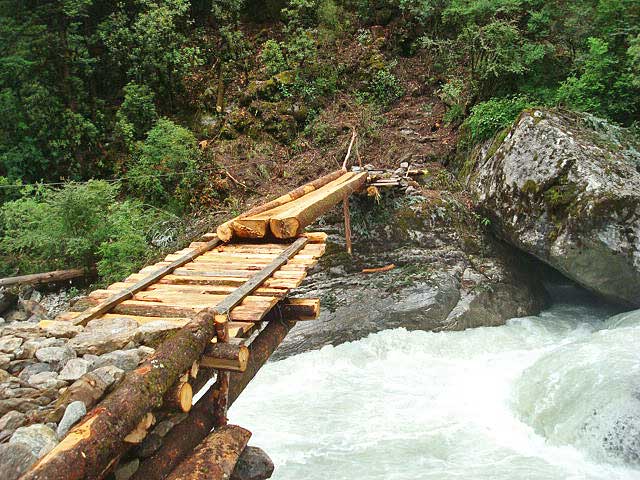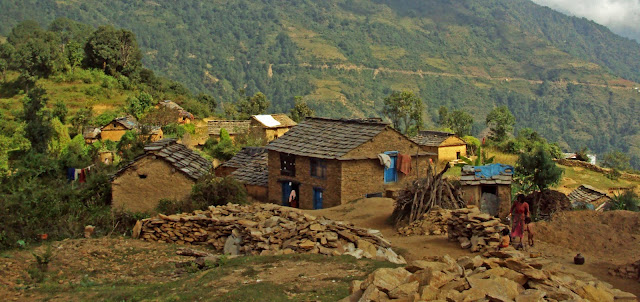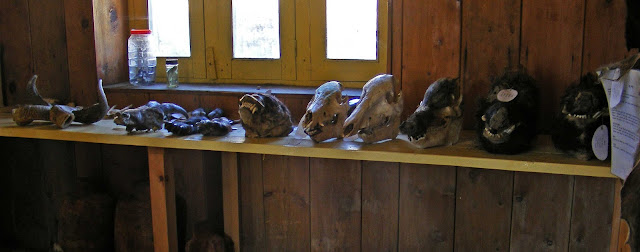During
the secondary level of our school days, there was an article on Tso-rolpa (Tso means lake in Tibetan language). All I recall of that article is
the mention of the fact that the lake is located somewhere in the Himalayan
region and that it is prone to outburst.
Years
passed but the traveler inside me kept reminding me of the lake. Meanwhile I had
joined a BSc in Environmental Science at Khwopa College, Bhaktapur. The
coordinator of Environmental Science faculty in the college was a geologist.
During his first lecture, he talked of Tso-rolpa. In the lectures that
followed, he mentioned his involvement in a geological survey of the lake. Thereafter,
there was rarely a lecture where he did not mention the lake.
I
do not know what triggered so much of his geological interest in the lake. But
his regular mention of the lake fueled my plan to explore this lake myself. The
time came in the monsoon of 2009, when I set off on a journey to Tso-rolpa.
We
follow the heart
On
the final day of the first terminal exam, I made a plan to visit Tso-rolpa and asked
my friend Krishna Dev Hengaju if he would like to join.
He replied without even thinking twice, 'Sure,
let's go'.
Having
made a decision, we paid a visit to the coordinator, to get his advice on which
geologic aspects we could study in the region.
He
replied: 'Monsoon is about to begin and you are planning of going to Tso-rolpa?
I do not recommend!'
Young
at heart, we were determined to make our plan a reality. So our ears remained
deaf to his response and the next morning we caught a local bus to Singati.
The
bus ran east through the black-topped Araniko highway to reach Charikot which
is the headquarter of Dolakha district. Beyond Charikot, the bus drove through
a dirt road and dropped us at Singati, a local market situated by the
confluence of Bhotekoshi and Tamakoshi Rivers.
It
started to rain while we were having snacks at Singati. We put on our raincoats
and started to walk. On the way we frequently encountered mule caravans, and had
sightings of a Squirrel Funambulus sp. and a flock of Kalij Pheasants Lophura
leucomelanos. These early sightings had pleasant impressions on us.
Darkness had fallen by the time we reached Jamune and we spent the night there.
 |
| Jamune |
A night in the middle of a forest
The
Upper Tamakoshi Hydroelectric Project (UTHP) had just begun its activities in
the area. An access road was being built to its powerhouse and the local people
were actively involved in the construction works. We passed many villagers
drilling stones from the side hills; some were even breaking them manually with
iron hammers.
 |
| Local people involved in construction works |
Seen in equal numbers were the local people carrying fuel in a doko
(a basket woven from bamboo), to be supplied for a tunnel construction being
carried at Gongar. While having lunch in a local shop we heard the rocks being
blasted for the opening of the tunnel.
 |
| The tunnel site at Gongar |
We
crossed a suspension bridge over the Tamakoshi River and ascended towards
Simigaun (2000 m asl). It was a tiring 90 minutes ascent to reach the village.
When we reached Gumbadanda, the clock had already ticked 4:50 PM but the sky
was still very bright. We asked with the villagers about the nearest settlement
that we would find from Gumbadanda.
'There
is a single house at Surmuche, which can be reached after about 90 minutes walk.
But you need to take a right turn from the main trail in the middle of the
forest to reach it', told a villager. So we continued.
The
trail passed through a dense forest. After about one and a half hours, we lost
our way. Broken twigs of trees were put on the trail to indicate that there is
no way ahead. We removed the obstructions and made useless attempts to locate
the trail. Realizing that we were stranded we thought of returning to
Gumbadanda, but it was already too late. After a short while, we rejoined the
main trail and gave up the thought of returning. At 7:45 PM we found ourselves
near an abandoned tea house in the middle of the forest. We were relieved. Complete
darkness ruled the scene and we were left with only one option that was to spend
the night in that abandoned tea house!
The
tea house had a big iron lock on its door. We tried to break the lock with
stones, but did not succeed. After about a few minutes of desperate attempts of
breaking the lock, we realized that the side walls of the house were loosely
sealed with wooden rods. Like thieves, we took out some of the logs from the
top row and entered inside.
As
we managed to get inside, we lit our torchlight. Our legs were bleeding as
leeches had sucked enough of our blood.
In
the meantime, we felt thirsty and checked our water bottles. They were empty.
We had carried some dry foods. Eating dry foods meant getting thirstier. We
also had some polo chocolates. An idea came to my mind, 'Let's put this
chocolate in mouth and leave it without chewing for some minutes. It will
produce a fair amount of saliva and we shall not be as thirsty!' The idea
worked.
We
began to feel cold as we were in shorts and thin jackets. We found some wooden
logs and dry ferns stored at a corner of the house and in no time we had lit a
warming fire.
There
were some wooden planks put as seat for the customers. We tried to make a
temporary bed with them. But they did not rest perfectly horizontal on the
floor.
Soon
it began to rain. To our despair, the metal roof of the house had rusted at
many places. Raindrops fell on our body through the holes on the roof. We
couldn’t sleep and stood up again. Chilled by the rain we lit the fire again.
The Rolwaling River was flowing down far away. Its thundering sound combined
with the raindrops hitting on the metal roof gave the impression that the rain was
growing heavier. Trembling and holding each other to stay warm, it took a long
time until total exhaustion let us fall asleep.
The
next morning we started the day early. We left the house feeling sorry to have
burnt so much of the firewood and the dry ferns, and felt fearful of getting caught.
 |
| Coming out of the tea house |
But
we were feeling very thirsty. This forced us to start moving in the hope of finding
potable water ahead. We could hear the Rolwaling River rushing down but it was
too far. The thirst grew so intense that we collected the dew drops on plant
leaves and the water drops seeping down from the rock crevices. After another
hour we found a small pit with water. We collected the water and drank it without
caring if it is worth drinking or not.
 |
| Collecting water from a pit by the trail |
Strangers
in Beding village
After
a walk of about four hours we found a small hut at Kelchey where we properly
quenched our thirst.
 |
| At Kelchey |
From Dongang, we followed the Rolwaling River and headed
east. A short while later we had to cross the River to move towards Beding
village. But the existing suspension bridge was completely destroyed by a
recent landslide.
 |
| The destroyed suspension bridge |
Luckily, the local people had put a new wooden bridge over
the River just the day before.
 |
| The wooden bridge |
As
the day progressed the fog kept getting thicker and reducing the visibility.
We
reached Beding (3700 m asl) at dusk. Located by the side of Rolwaling River, the
Sherpa village had a charming outlook.
 |
| Beding village |
With no warm clothes we were shaking. There
was only one lodge in the village. The price was much higher than we had
expected. So we opted for an accommodation in a local house and inquired a few
villagers. To our surprise, nobody seemed to be interested in accommodating us.
Everyone said, 'We have no room. Ask in the next house.'
We
later learned that a group of young boys had come to visit Tso-rolpa a few
weeks before. They had stolen some equipment from the office of Tso Rolpa GLOF
Risk Reduction Project (TRGRRP) situated by the lake. The group had also stolen
an idol from the monastery of Beding. These events had made the villagers
suspicious of any outsiders.
A
young girl that I had asked if she had a room for us to stay replied with a
sharp scolding.
It
was revealed later that the girl and her sister were living in that house alone.
Seeing us moving around the village a drunkard had told the two sisters, 'There
are two young boys from the city. Tonight, you either sleep with them or sleep
with me!'
Without
asking anyone further we returned to the lodge. But now the owner was not in the
mood anymore to give us a room. His wife took pity and managed a room for us.
By the Tso-rolpa
We
reached Na gaon (4180 m asl) after a two hours walk from Beding.
 |
| Na gaon |
Another
two hours of walk and we were by the Tso-rolpa. Situated at an elevation of
4580 m asl the average length of the lake is 3.20 km at a width of 0.5 km and
depth of 138 m.
 |
| Tso-rolpa |
Considering
the risk of a Glacial Lake Outburst Flood (GLOF) event, TRGRRP was already in
place since nine years. Implemented by the Government of Nepal with the
economic support from Netherlands Development Agency (NEDA), the project had
channelized water from the lake through an outlet. Three staffs were appointed
to periodically open and close the gate of the outlet to check the rise in
water level of the lake. The out flowing water had been used to run a small
hydro power plant, the electricity from which was used to lit the office and to
operate the equipment.
We
spent two hours by the lake. As it got colder fast, we descended down to Na gaon.
For
the dinner we had dhindo of millet (recipe: millet flour is put in hot water,
stirred till it solidifies and served). We had ordered it ourselves but had difficulty
eating it since we were not used to such a dish. However, the fresh milk of yak
was too tasty.
The vanished trails
The
next morning we took leave of Na gaon and descended fast. At some places
the trails we had come through had completely disappeared as the villagers had
cut the entire hills to open the track for the UTHP.
The
TRGRRP had put one siren at each village from Na gaon upto Simigaon to
notify the villagers if a GLOF event occurred. But the sirens were not
functional anymore as most of the important components such as batteries and
solar cells were stolen.
 |
| A siren put to inform of the GLOF event |
The
monsoon had progressed after we moved up and it rained almost every day. Near
Bhorley, the usual trail was blocked due to a landslide. The villagers were
busy making an alternate trail through the nearby forest.
 |
| Villagers opening an alternate trail near Bhorley |




















